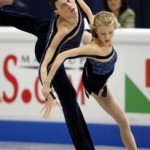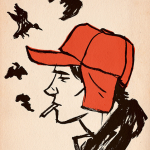If you think that knitting is on the brink of becoming a lost art, you might want to think again. There’s a lot of knitters out there who would politely disagree, and a surprisingly large bunch of them have made their craft into a full-time job. Aside from the obvious wooly occupations that might immediately come to mind (such as working for a yarn company, at a craft store, or teaching classes), hosting sites like Etsy and Ravelry have enabled something relatively new: Independent pattern designers. These talented individuals dream up a design, draft a pattern, grade different sizes (when applicable), produce a sample, oversee the styling, modelling, and photography of the finished item, and put the whole thing together in PDF format–often with schematics or complicated stitch charts. They decide on pricing, create their own branding, and self-promote. Unlike freelancers, independent designers are paid directly at the point of sale. While designers may collaborate with others (such as a photographer or technical editor), the process takes place on a grassroots level from start to finish.
On Ravelry alone, sales of these patterns reached 1.3 million as of January, 2012–just five years after the site opened in beta.
Impressed yet?
In a world saturated with overlyPhotoshopped photos of women with perfect make-up, ultra-shiny hair, and surgically-enhanced (by knife or by mouse click) figures, the knitting industry offers something strangely unique: A chance for women to decide how they will represent themselves. While no one can entirely escape the influences of their culture, the type of images frequently found on Ravelry pattern listings come–pardon the pun–darn close. Women of all sizes and shapes strike poses that may be whimsical, coquettish, or serene. They pick out their own outfits. They apply their own make-up and fix their own hair. Their smiles are natural–and simply gorgeous.
They truly represent their own brands. That’s what’s going in the knitting community: The people are representing themselves. They have names, and faces.
Not only is that empowering on it’s own, but by nature knitting allows even further room for personalization. Knitters can make their own alterations or additions to a particular to suit their own style, or tweak the sizing to accomodate a longer torso or smaller bust. And Ravelry users don’t just upload patterns–they upload finished projects as well. One popular sweater pattern has almost 9,000 project pages containing photos of the finished piece, usually modelled by the knitter. If seeing it on the original model wasn’t enough, Ravelry users can search project pages by size in order to see what it looks like on someone who also happens to possess similar measurements to their own.
Can you imagine a clothing store catalog showcasing their new summer clothing lines only on women who wear a size 14–the average size for women in the US today? Or how about the items predicted to be top-selling shown in every size? Or the next time you pick up a Harper’s Bazaar, seeing that the majority of the ads contain size 14 models? The implication from the fashion industry is that no one wants to see those women. No one wants clothes if they are the ones selling them, and no one will look at an ad or watch a movie if they’re the ones in the starring role. They’re considered a niche at best, despite the majority of us looking just like them. Doesn’t that feel a little backwards?
With over two million members and counting, Ravelry is booming. Maybe that should send a message to the fashion industry: If we can include everyone, so can you. It is possible to re-orient culture, and it’s about time for some change. Ravelry built itself around an innovative idea: That what individuals had to offer was worthwhile. It’s a lesson other businesses might do well to learn, one that could even hold the key to the future of fashion.
Note: Featured image is from knitty.com, an independent online zine. Click on the other images to visit the websites of the designers who created the garments shown.











